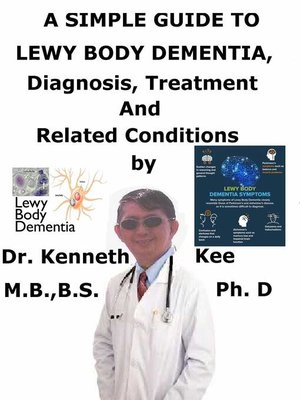A Simple Guide to Lewy Body Dementia, Diagnosis, Treatment and Related Conditions
ebook
By Kenneth Kee

Sign up to save your library
With an OverDrive account, you can save your favorite libraries for at-a-glance information about availability. Find out more about OverDrive accounts.
Find this title in Libby, the library reading app by OverDrive.



Search for a digital library with this title
Title found at these libraries:
| Library Name | Distance |
|---|---|
| Loading... |
This book describes Lewy Body Dementia, Diagnosis and Treatment and Related Diseases
Lewy body dementia (LBD) is a disease linked with abnormal deposits of a protein termed alpha-synuclein in the brain.
These deposits, termed Lewy bodies, affect chemicals in the brain whose alterations, in turn, can cause problems with thinking, movement, behavior, and mood.
Lewy bodies are small, circular deposits of alpha-synuclein proteins that collect in brain cells and are often discovered in Parkinson's patients.
Lewy-Body Dementia (LBD) is normally discovered in those with no family history of the disorder.
It is not known precisely how Lewy bodies affect brain function and cause dementia.
Doctors believe that the bodies disrupt the functioning of dopamine and acetylcholine, messenger chemicals accountable for regulating memory, mood, learning, and cognition.
Most manifest with a movement disorder part and the diagnosis obtained in life often depends on the interval between the diagnosis of dementia and the start of movement disorder symptoms.
If a medical diagnosis of Parkinson disease is accompanied by dementia a minimum of 1 year later, then a diagnosis of Parkinson disease dementia (PDD) is made.
If the start of dementia happen before or is concurrent with the start of Parkinson disease, then the medical diagnosis of dementia with Lewy bodies (not to be confused with LBD) is made.
By the time the postmortem diagnosis of LBD can be verified, years would have passed since the initial medical diagnosis, making Parkinson disease dementia and LBD difficult to differentiate.
Most LBDs are sporadic and are often linked with higher age and the male sex.
Lewy Body Dementia (LBD) comprises 2 medical entities:
1. Dementia with Lewy bodies (DLB) and
2. Parkinson disease dementia (PDD).
It is a progressive degenerative brain disorder featured by dementia, psychosis, and symptoms of Parkinson disease.
DLB and Parkinson disease dementia have typical neuropathology alterations, such as deposit of alpha-synuclein in Lewy bodies and neurites, and loss of tegmental dopamine cell populations and basal forebrain cholinergic populations.
It is the third most frequent form of dementia after Alzheimer disease and Vascular dementia.
It features the deposition of Lewy bodies in the brain that are intra-neuronal cytoplasmic inclusion bodies having aggregates of alpha-synuclein and ubiquitin.
Diagnosing LBD can be difficult.
Early LBD symptoms are often confused with similar symptoms present in other brain diseases or in psychiatric disorders.
It is a progressive disorder, indicating that the symptoms start slowly and worsen over time.
The disease persists an average of 5 to 8 years from the time of diagnosis to death, but can vary from 2 to 20 years for some people.
In the early stages of LBD, symptoms can be negligible, and people can function fairly normally.
The most frequent symptoms are changes in cognition, movement, sleep, and behavior.
As the disease progresses, people with LBD require more help due to deterioration in thinking and movement abilities.
In the later stages of the disease, they often are dependent totally on others for assistance and care.
Some LBD symptoms may react to treatment for a period of time.
Several medicines and other treatments are accessible to treat LBD symptoms.
Presently, there is no cure for the disease.
Research is improving the understanding of this difficult disorder, and advances in science may one day result in better diagnosis, improved care, and new treatments.
TABLE OF...







